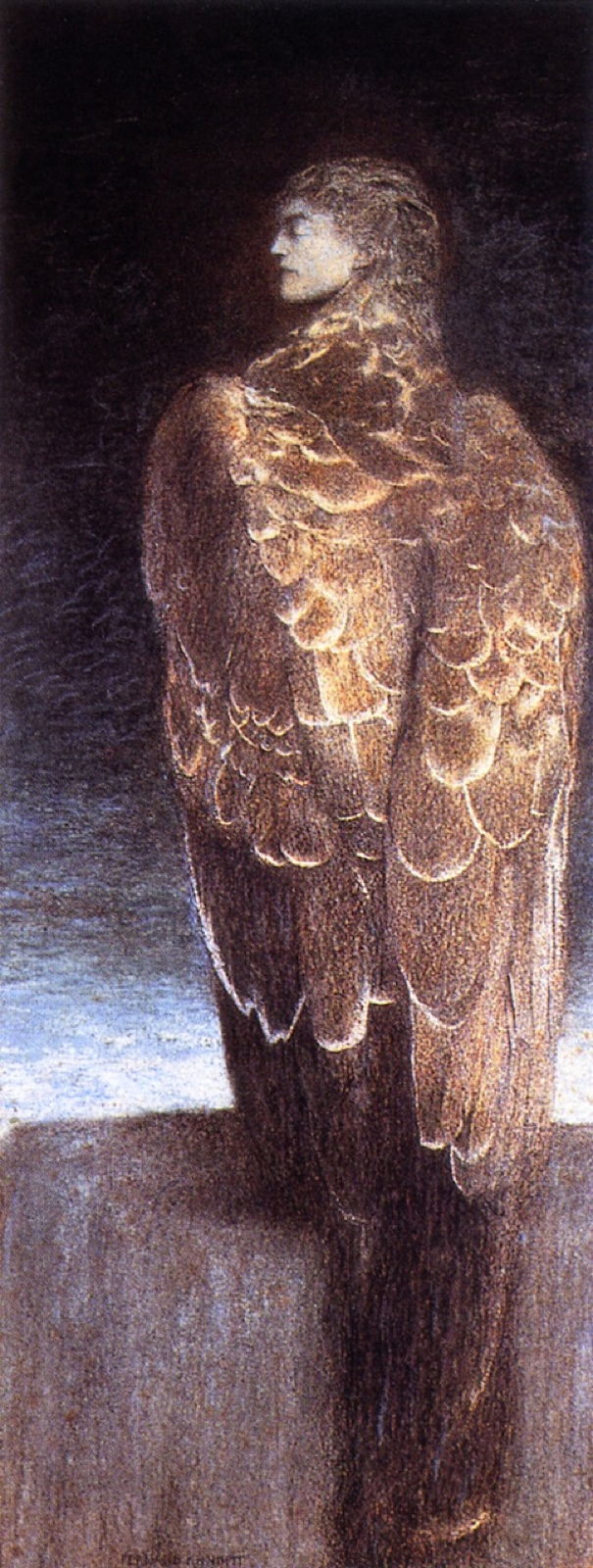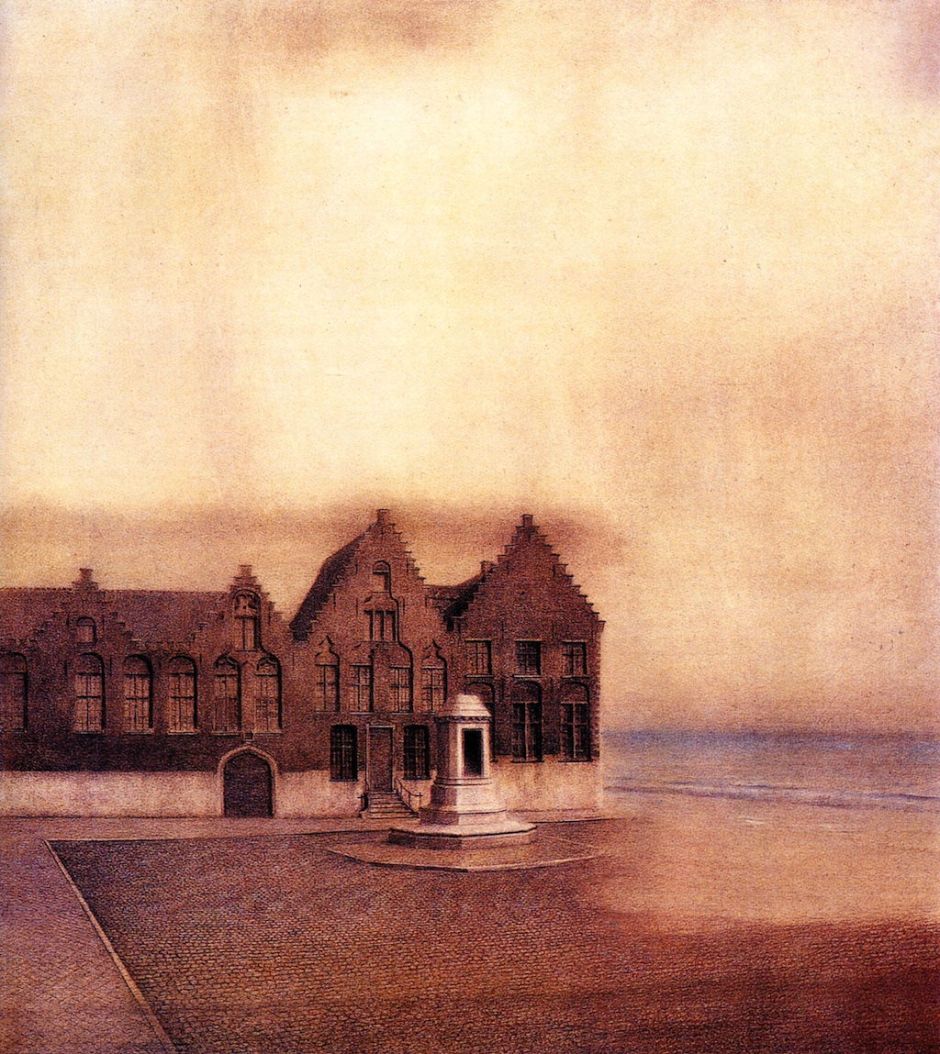I apologise for being a little late to commemorate the centenary of the death of the great Belgian Symbolist Fernand Edmond Jean Marie Khnopff (1858–1921), who died in Brussels on 12 November 1921. This article is a brief summary of his career, and shows a selection of his paintings of mysterious beauty and fascination.
He was born into an affluent family of lawyers, and started painting when a child. He initially went to university to read law, but developed a passion for literature, and dropped out. In 1876 he enrolled in a drawing course at the Académie Royale des Beaux-Arts in Brussels, and graduated from there in 1879, winning third prize for historical composition. One of his fellow students there was James Ensor. Khnopff started travelling to Paris in 1877, where in 1878 he attended the Exposition Universelle, and for a year from 1879 attended classes at the Académie Julian.
At first, he mainly painted portraits, exhibiting in Brussels in 1881, but had a poor critical reception. In 1883, he was one of the co-founders of the avant garde group of Les XX, and exhibited regularly with them from 1884 until the group collapsed in 1893.

Khnopff’s wonderful portrait of Jeanne Kéfer (1885) is one of these early works, and probably his most famous today. This little girl was born in Ixelles, a suburb of Brussels, to a friend in the prosperous middle class. She is shown looking directly at the viewer, a small figure in front of the much larger door behind her. X-ray studies have shown that she originally held a single flower or small bouquet in her left hand, which was removed during subsequent painting.
Khnopff’s desire was to transcend physical reality with a new reading of the here and now, something this painting achieves with subtlety. Immediately recognised as a major work, it was exhibited in the Salon of Les XX in 1886, and toured internationally afterwards.

Khnopff’s favourite model, his sister, is the subject of his Portrait of Marguerite Khnopff (1887). In contrast to Jeanne Kéfer, Marguerite averts her eyes from the viewer, looking to her left, and her left arm is folded behind her back, with her right elbow, almost as if the two arms belonged to different people. Khnopff was an enthusiastic user of photography as an aid to his painting, and took several photos of Marguerite in different clothes and poses to help him compose the next painting.

Lawn Tennis, or Memories (1889) is almost a pastel collage of paintings of his sister, that on the left dressing her in the same high-necked white dress as in her portrait of 1887. He shows here how skilled he has become at constructing the feeling of otherworldliness which is so characteristic of his paintings.
In 1889, he visited Britain, where he made friends with Holman Hunt, Rossetti, Burne-Jones, and others whose work he had long admired. As this connection developed, he exhibited regularly in Britain, and from 1895 to 1914 he reported on the continental European scene for the British art journal The Studio.

He also painted some landscapes, among them At Fosset: Rain (1890), which was painted at the Khnopff’s family country home in the forest of the Ardennes. Empty of people and animals, its bright areas in the field at the lower left, the blank white wall of the building, and at the horizon, seem almost unnatural. This is one of the first examples of landscape paintings which demonstrates the distinctive effect of rain in intensifying the perception of chroma, a phenomenon since noted and depicted by other artists.

Silence (c 1890) is another pastel which has a simple motif – a young man dressed in a gown and gloves, holding his left index finger to his lips as if calling for silence – which appears to have a different reality. This strange feeling is enhanced by the low position of the viewer, which makes the figure seem almost angelic.

Among his most enigmatic works, I Lock my Door upon Myself (1891) was inspired by, and quoted from, a poem by his friend Dante Gabriel Rossetti’s sister, Christina Rossetti (1830-94), Who Shall Deliver Me? which considers God’s role in resolving inner turmoil:
God strengthen me to bear myself;
That heaviest weight of all to bear,
Inalienable weight of care.
All others are outside myself;
I lock my door and bar them out
The turmoil, tedium, gad-about.
I lock my door upon myself,
And bar them out; but who shall wall
Self from myself, most loathed of all?
If I could once lay down myself,
And start self-purged upon the race
That all must run! Death runs apace.
If I could set aside myself,
And start with lightened heart upon
The road by all men overgone!
God harden me against myself,
This coward with pathetic voice
Who craves for ease and rest and joys
Myself, arch-traitor to myself;
My hollowest friend, my deadliest foe,
My clog whatever road I go.
Yet One there is can curb myself,
Can roll the strangling load from me
Break off the yoke and set me free.
The sculpted head in the background is of Hypnos, classical Greek god of sleep, who lived in the underworld with his twin brother Thanatos, god of death. They had already been painted by JW Waterhouse in his Sleep and His Half-Brother Death (1874). To the right of that head is a view of a mediaeval town, with a single dark figure. Three rare orange lily flowers are shown in the foreground, and the piercing blue eyes of the woman stare through the viewer.

Khnopff read widely and was faithful to a range of sources of classical myth, in his wonderful pastel painting of Sleeping Medusa from 1896. Described as winged, the artist shows Medusa as a huge aquiline creature with a human head.

Art, or Caresses (1896) is an even more extraordinary work, showing an androgynous youth holding an ornate caduceus (less the intertwined serpents) in his right hand, so presumably being Mercury/Hermes. His nipples appear to have been tattooed, or bear jewellery, and he is bare to the waist. He stands cheek-to-cheek with a leopard with a young woman’s head, perhaps a form of sphinx.
The background encourages even greater speculation as to its interpretation. Behind the leopard’s body is a wooden booth, which has non-Roman characters or ideograms written on it. Further in the distance to the right are two blue columns, with bases and caps of gold.

Khnopff’s Incense (1898) places his sister Marguerite in a heavy cope of brocade bearing a thistle motif. Her hands are in long silk gloves, the left holding a silver and glass incense burner by its base. Her head is covered with more folds of fine fabric, and behind – either seen through glass or reflected in a mirror – are the windows of a cathedral. Seen now as one of the masterpieces of European symbolism, it’s as mysterious as the wry smile on the model’s face.
From 1900, Khnopff was influenced by the Vienna Secession, and in a series of design and decoration projects came to know Gustav Klimt and others associated with that movement; these included the banker Adolphe Stoclet who commissioned work from Klimt and Khnopff. Although something of a recluse, thanks to increasing popularity of his paintings he attracted quite a following, and was awarded the Order of Leopold.

Secret-Reflection (1902) is a pair of paintings in pastel and crayon on paper. In the upper image, sister Marguerite is again swathed in clothes, this time a brilliant blue robe draped on her body, and a pale indigo wrap on her head, with elbow-length white silk gloves. Her right hand is caressing the mask of a woman, which seems to be fixed to a cerulean blue fluted column, similar to the pair seen in the distance in his Caresses.
The lower painting shows a flooded town, probably the city of Bruges from his childhood memories, which was often a source of his motifs.

Khnopff’s The Abandoned City (1904) was inspired by Woensdagmarkt Square in Bruges. Deserted, its cobbles fade gradually to a flat beach from the North Sea coast, with small waves rolling in. Although the majority of the image is taken up by the sky, it has only ill-defined areas of light and dark, and is as featureless as the square is desolate.
He died on 12 November 1921, in Brussels, at the age of 63. Anyone seeking illumination from his personal papers must remain for ever in the dark, as his family burned them all following his death.
References
Draguet M (2004) Portrait of Jeanne Kéfer, Getty Museum. ISBN 978 0 892 36730 6.

